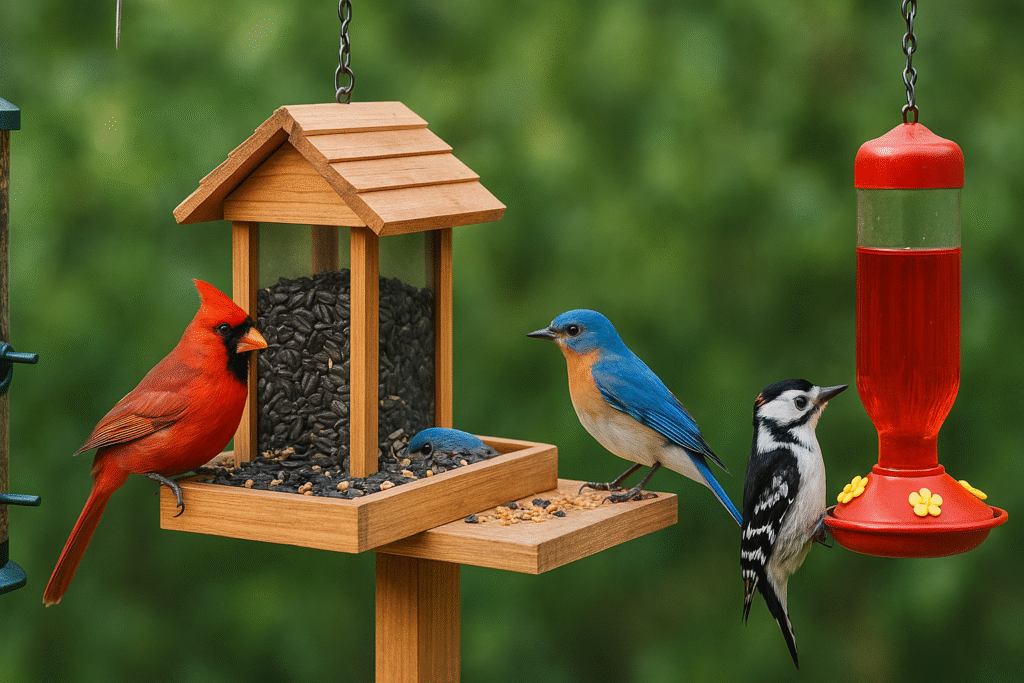
Welcome to the Buffet of the Birds
Setting up a bird feeder might seem as simple as tossing up a bag of seed and hoping for a feathered frenzy—but choosing the right feeder is a bit like picking the right tool for the job. Whether you’re wooing finches, drawing in downy woodpeckers, or setting the stage for hummingbirds to zip by, each feeder style serves a specific function. Let’s break down what kind of feeder fits your goals (and your feathered clientele).
1. Know Your Bird Guests
Before grabbing the first feeder on the shelf, think about who you’re feeding. Some birds are polite diners (hello chickadees), while others are messy eaters (we’re looking at you, blue jays). Here’s a quick match-up guide:
| Bird Type | Feeder Style | Preferred Food |
|---|---|---|
| Finches & Chickadees | Tube Feeder | Nyjer seed, sunflower seeds |
| Cardinals & Grosbeaks | Hopper or Platform | Sunflower seeds, safflower |
| Woodpeckers & Nuthatches | Suet Cage | Suet blocks |
| Sparrows & Doves | Ground or Tray Feeder | Mixed seed, cracked corn |
| Hummingbirds | Nectar Feeder | Sugar water (no dye!) |
2. Feeder Types and Their DIY Friendliness
Let’s roll up our sleeves and get into the feeder types you’ll commonly find at your local hardware store—or build yourself if you’re feeling handy.
🧪 Tube Feeders
- Great for small birds like finches, titmice, and chickadees.
- Keeps seed dry and deters larger birds.
- DIY Tip: Use a length of PVC pipe and drill in perch holes for a custom touch.
🏡 Hopper Feeders
- A covered, house-shaped option that stores seed in bulk.
- Welcomes a wide range of birds, including cardinals.
- Often mountable on poles or hanging from trees.
🪶 Platform or Tray Feeders
- Open buffet-style: easy to access and clean.
- Good for ground-feeding birds like juncos and mourning doves.
- Not ideal in rainy areas unless covered.
🧲 Suet Feeders
- Cage-style holders for suet cakes.
- Attract woodpeckers, nuthatches, and other insect lovers.
- Pro Tip: In summer, switch to no-melt suet to avoid a greasy mess.
🍹 Hummingbird Feeders
- Bright red with feeding ports for nectar.
- Must be cleaned every few days (especially in hot weather).
- DIY bonus: a mason jar and a little tubing can get you started.
3. Think Location, Location, Location
Where you hang your feeder is just as important as what kind you choose:
- Place feeders near shrubs or trees to offer birds quick cover from predators.
- Avoid spots that are too windy or completely exposed.
- Keep feeders away from reflective windows to reduce bird collisions.
Oh, and don’t forget the squirrel factor—use baffles or pole-mounted feeders to slow those furry freeloaders down.
4. Consider Cleaning & Maintenance
A dirty feeder is like an unwashed lunchbox—it won’t go unnoticed. Look for designs that are easy to take apart and scrub. Clean your feeders every couple of weeks with warm water and a vinegar rinse to keep your birds healthy and your backyard gossip-free (avian drama is real).
5. Start Small, Expand as You Go
Don’t feel pressured to launch a five-star bird restaurant right away. Start with one or two feeders based on your local bird population and expand as your knowledge—and enthusiasm—grows. It’s a hobby that builds on itself, one peep and flutter at a time.
🛠️ Pro Tip from the Helpful Hardware Guy:
“Choosing a bird feeder is like choosing a paintbrush—you need the right one for the job, and sometimes the cheapest option just makes a mess. Invest in quality, think like a bird, and keep those feeders clean. Your feathered friends (and your backyard) will thank you.”
Final Thoughts
With the right bird feeder, your yard transforms into a vibrant hub of life, color, and song. It’s more than just tossing out seed—it’s building a backyard ecosystem. And whether you’re shopping at your local hardware store or crafting a feeder from scratch, you’re making a difference—one wingbeat at a time.
